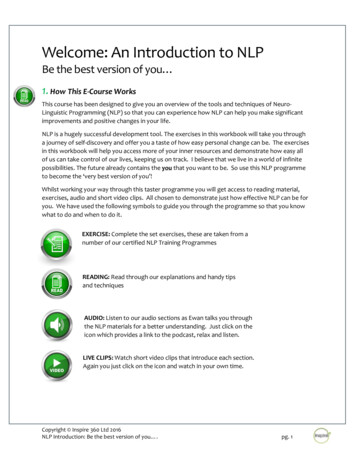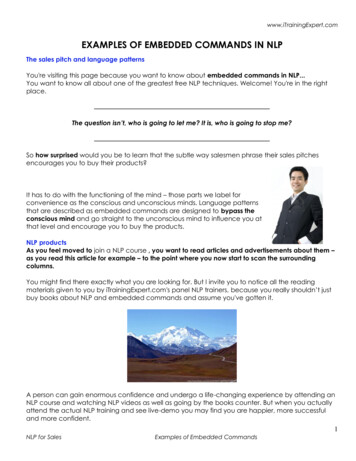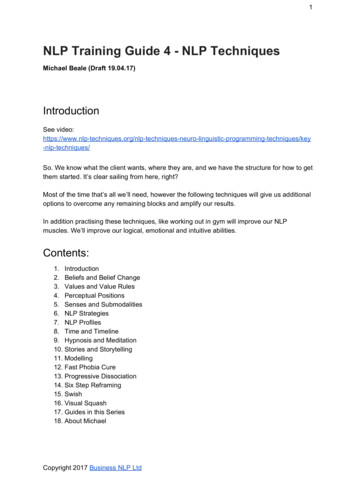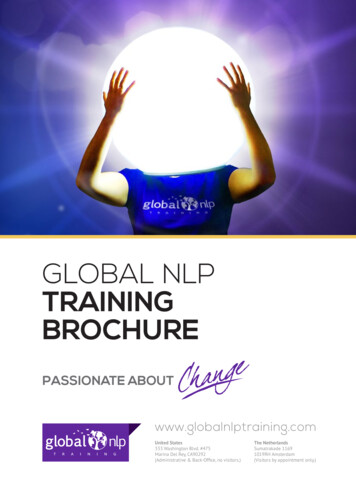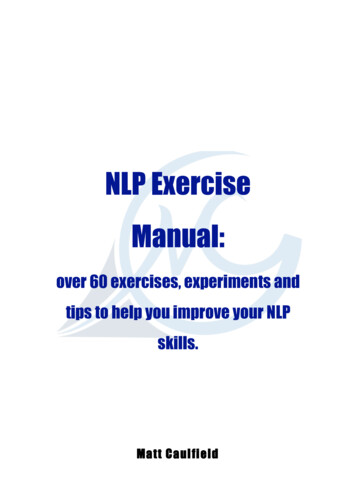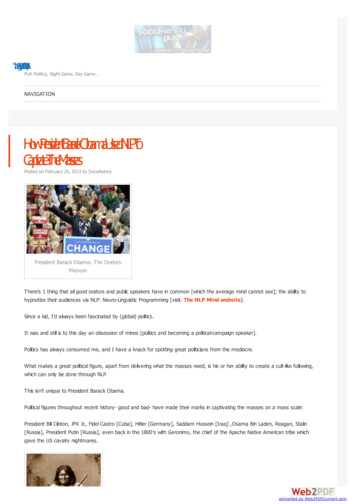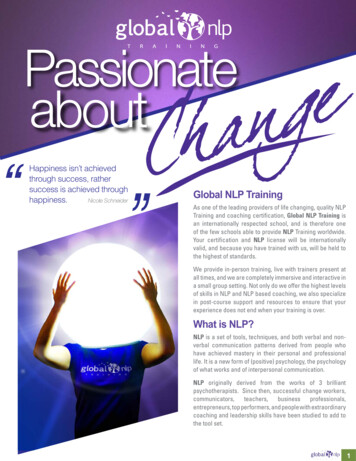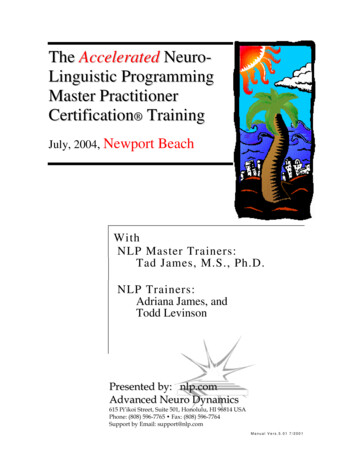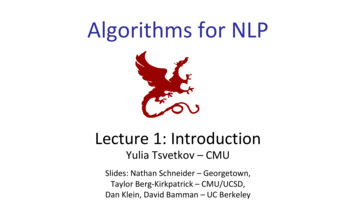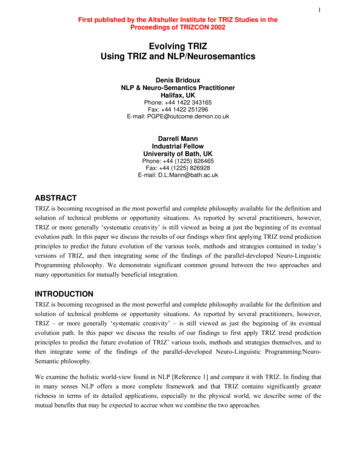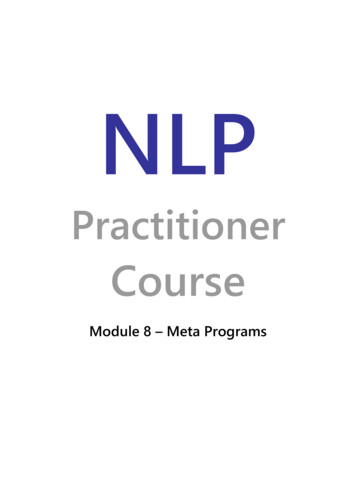
Transcription
NLPPractitionerCourseModule 8 – Meta Programs
ContentsModule 8 - Meta Programs . 3Meta Programs in Business . 5Towards/Away From . 5General/Specific . 7Proactive/Reactive . 8Internal/External .10Sameness/Difference .12Options/Procedures .152
Module 8 - Meta ProgramsWhat Are Meta Programs?Meta Programs are one of the sets of filters we use to create our map ofthe world. They run 'in the background', so we are usually not consciouslyaware of them. They drive:what we pay attentionto what we respond towhat motivates ushow we interact with the people around usthe kind of language that will influence usAs the name implies, Meta Programs are at a different logical level to ourother mental 'programs' such as strategies. They influence the type ofinformation fed into our strategies, the goals we set for ourselves, theway we make decisions, and the motivation behind our strategies.History of Meta ProgramsThe term 'metaprogramming' first appeared in John C Lilly's bookProgramming and Metaprogramming in the Human Computer (1968). Lillypresented the human nervous system as a biological computer, running'programs' either hard-wired or learned. 'Metaprogramming' is changingthe central control system so that we can learn more quickly and selectmore useful programs.Richard Bandler introduced meta programs to NLP in the late 70s as away that people maintained coherency in their cognitive patterns.Leslie Cameron-Bandler and others investigated further, using the MetaModel to identify a list of Meta Program patterns for use in therapy whicheventually grew to around 60. One of her students, Rodger Bailey,simplifed the model into 14 patterns for use in a business context - theLAB Profile (Language and Behaviour patterns) as set out in Shelle RoseCharvet's excellent Words That Change Minds.James and Woodsmall's 'Time Line Therapy and The Basis Of Personality'presents a similar simplified set of patterns, and links them to Jungianpersonality characteristics as used in the Myers-Briggs Type Indicator.Note: you will also see meta programs written as 'metaprograms' or, inthe UK, 'metaprogrammes'. This last is a misnomer - 'programs' is ametaphor drawn from the IT industry, which even in the UK uses the USspelling of 'programs'.3
What Meta Programs Are NotA way of putting people into boxes at the Identity level! Theymay be influenced by context and the person's emotional state.Either/or - instead, each meta program is like a spectrum and mostpeople will be somewhere between the extreme endsAbsolute. Meta programs are context-dependent - for example,people tend to be more detail-focused about subjects that interestthem.Five reasons you need to know about MetaProgramsAchieving rapport: meta programs are another thing you can matchto help people feel at ease with you.Self-awareness: if you are aware of your own meta programpreferences, you will have a better idea about activities and careerpaths that allow you to play to your strengths.Recruitment: every job has an ideal meta program profile. If yourecruit people to match that profile, they will perform better in thatrole. You can even write job ads in a way that will attract the peopleyou want, and put off the people that won't be suited to the job.Influencing: you can use language that suits people's metaprograms to influence them and communicate with them in the waythat it is easiest for them to understand.Managing change: describing changes in a way that is compatiblewith people's meta program profiles will make it easier for them toaccept and feel enthusiastic about changes, and avoid triggeringknee-jerk resistance.Sales: you can help people to reach a buying decision by presentingthem with information in the style and sequence that works for theirmeta program filters.Detecting Meta ProgramsDepending on the specific meta program, you can detect them from:The words that people use, the structure of their language patterns,and the way they talkThe way they behaveTheir history, for example how frequently they have changed jobs4
Meta Programs in BusinessTraditionally, meta programs have been taught at Master Practitionerlevel. This is to do with the fact that they were discovered later than the'classic' NLP components like submodalities and anchoring, rather thansaying anything about their complexity or level of difficulty.In fact, Meta Programs are easy to understand, recognise and use - andtoo useful to leave out of a business-oriented course. This Practitionercourse covers six of the most useful meta programs for business, withtips on how to identify them, job roles that different patterns may suit,and advice on how to influence and manage them.(see also the Convincer Channel and Convincer Mode in the StrategiesSection - these are also classed as meta programs but it's more useful tocover them under buying strategies)Towards/Away From(also known as 'Direction Filter' or 'Motivation Direction')Are you motivated towards goals, targets and what you desire, or awayfrom problems and difficulties?Extreme 'Towards' people will be gung-ho, and will overlook potentialproblems that can trip them up - think 'invasion of Iraq' or stock marketbooms.People who are very 'Away-From' will be perceived as fault-finding andoverly negative or cynical by their colleagues, and will lack directionunless given a problem to solve or a crisis to fix.They also will run out of motivation the further away they get from whatthey wanted to avoid - so they might never lose that last 8 pounds, or getclose to their professed goals but let them slide before they finally attainthem.Like all meta programs, this one is context-dependent. You may find thatsomeone is strongly 'Towards' or strongly 'Away-From' in almost allcontexts that you ask about.Identifying the Towards/Away From patternAsk "What do you want in a job?" (or car, or relationship, or house). Thiswill start to give you the person's values. For each value, you can ask"Why is that important to you?"5
The answers will be either towards, away-from, or a mixture. Somevalues may be more towards or away-from than others.Keep asking "Why is that important to you?" - at least three times. Theinitial answer is likely to be coloured by the prevailing culture - e.g. in theUS you are likely to get a 'towards' answer - so you need to go a bitdeeper to find the person's real pattern.TowardsLanguage: talking about what they want, what they would like to see,what they can get, achieve, benefits.Body language: nodding, gestures indicating the vision they are movingtowards, 'inclusive' gesturesAway-FromLanguage: what to avoid, 'yes but', problems (including solving problems),pitfalls, avoiding, removing, "hang on a minute", comparative deletions,modal operators of impossibility, referring to target dates as 'deadlines'.Body language: dismissive or 'warding off' gestures, shaking headLook out for 'concealed away-froms' in language patterns - the away-fromis not explicitly mentioned but it's there in the person's internalrepresentations:1. Comparative deletions e.g. "It's better to have money". Better thanwhat?2. Modal operators of necessity e.g. "You've got to have money, haven'tyou?" What happens if you don't?Job role examplesA "Towards" pattern is useful in: visionary leaders, entrepreneurs,creatives, ideas people. It's often found in change agents, coaches, andNLP Practitioners.An "Away-from" pattern is useful in: health and safety officers, processcontrol, proof-reading, maintenance engineers. Often found in medicine,pharmacy, solicitors, accountants, civil service.6
Influencing and managingTowards: this is what we can achieve, this is what it will get you,benefits, results, achievement, winning, advantages, what you can have,just think about it!If you are an extreme 'Towards' person, you may want to look at themassive benefits of doing an occasional 'minesweep' to make sure theroute to your goals stays clear of potential problems.Away-From: solve the problem, fix it, avoid, sort out, eliminate, this iswhat will happen unless we., these will be the consequences if we don'tdo it.If there are no immediate problems to motivate the Away-From person,ask them to look into the future to see the problems that will occur if theydon't take action now.Advertisements for cleaning products often use a lot of away-from imagery.General/Specific(also known as 'Chunk Size Filter' or 'Scope')What level or chunk size of information are you comfortable with - the bigpicture or the details?This meta program is about which levels of the 'Hierarchy of Ideas' theperson is comfortable operating with.A person at the 'General' end of the spectrum will think in terms ofabstract concepts and generalisations rather than specific details.When faced with too much detail they will feel overwhelmed or bored.A person at the 'Specific' end of the spectrum will feel more comfortablewith facts, details and step-by-step sequences. Abstractions, and the bigpicture on its own, will feel vague and nebulous without more details andspecific examples.Identifying the General/Specific patternThis pattern will come out in any general conversation. For an example,you could ask the person what they are currently working on, or how theirday has been.7
The 'Specific' person's answer will be in the form of a step-by-stepnarrative with lots of specific detail. They will use lots of qualifiers(adjectives and adverbs). If you interrupt them, they may start at thebeginning again, or else re-start where they left off.The 'General' person's answer will be shorter, in the form of a summary.It may not be in a temporal sequence, but will aim to give you what thespeaker sees as the most important aspects first. This may seem like arandom order to the listener.Job role examplesGenerally speaking, the higher level of abstraction a person can handle,the higher they can go in an organisational hierarchy (the upper ranks ofthe army are even called 'generals'). The ability to think strategically - inother words, to be able to work with high levels of abstraction - is usuallyessential for board-level roles. Having said that, people need to able tohandle details to perform well at lower levels on their way up.A detail focus is needed for: quality control, proofreading, health andsafety, bookkeepingA big picture focus is needed for: leadership, creative rolesInfluencing and managingAs with all the meta programs, match where the person is on the spectrum inorder to communicate with them. If you need a 'General' person to be morespecific, or vice versa, start from where they are and use pacing and leadingto help them move up or down the levels of abstraction.General: give the big picture, the overview, 'the real issue is.', 'in anutshell'. Calibrate to notice if they are getting bored or overwhelmedwith detail.Specific: use examples and sequences (first., second.), give detail,exactly, specifically, precisely. Calibrate to notice if they are looking lostor if what you're saying is going over their head.Proposals and reports often contain an executive summary (for 'General'readers) and appendices with lots of detail and facts (for 'Specific' readers).Proactive/Reactive(also known as 'Action Filter' or 'Motivation Level')8
Do you take the initiative and leap into action, or do you prefer to analyseand wait for others?'Proactive' people are self-starters, and do not wait for others before theyact. They are focused on achieving results and may upset others in theirwillingness to get there.'Reactive' people won't act until they have analysed the situation, or untilother people prod them into action. Other people may get frustrated withtheir apparent inactivity.Identifying the Proactive/Reactive patternThis pattern will appear in language structure and body language.ProactiveLanguage: Short, direct sentences, often with a 'command' tonality onstatements or even questions. Active verbs. Active verbs and verb patternsindicating an 'at cause' mentality. Expects to be listened to. A need to act.Body language: Generally fast. Fidgety, pencil-tapping, won't sit still forlong periods (you will definitely notice this if you have a strongly'Proactive' person in a meeting or training course).ReactiveLanguage: Passive verbs, nominalisations, long sentences that tail off,verb patterns indicating an 'at effect' mentality (things happen to them,others 'make' them do things, lots of model operators of necessity).Conditional words like 'might', 'could', 'would'. Can have 'question'tonality on statements. A need to understand.Body language: Able to sit still for long periods. May seek lots of eyecontact - as if looking to others for approval or checking that they arebeing listened to.Job role examplesA Proactive pattern is useful for: sales people (outgoing sales), businessowners, leadersProactive people need to be given things to do, otherwise they becomebored. If you are recruiting for a role needing a Proactive pattern, you canscreen out 'reactives' by requiring applicants to phone.9
Don
NLP Practitioner Course . The term 'metaprogramming' first appeared in John C Lilly's book Programming and Metaprogramming in the Human Computer (1968). Lilly presented the human nervous system as a biological computer, running 'programs' either hard-wired or learned. 'Metaprogramming' is changing the central control system so that we can learn more quickly and select more useful
